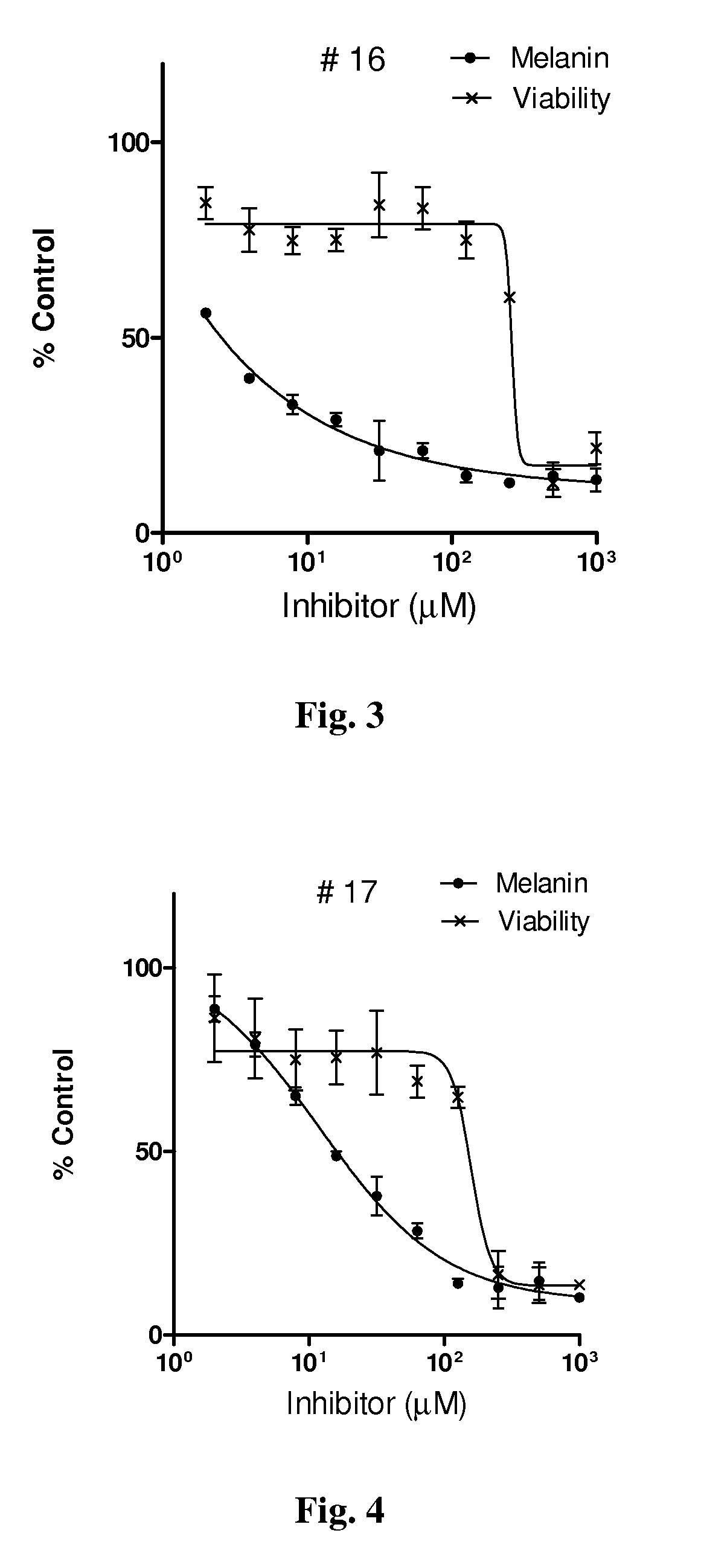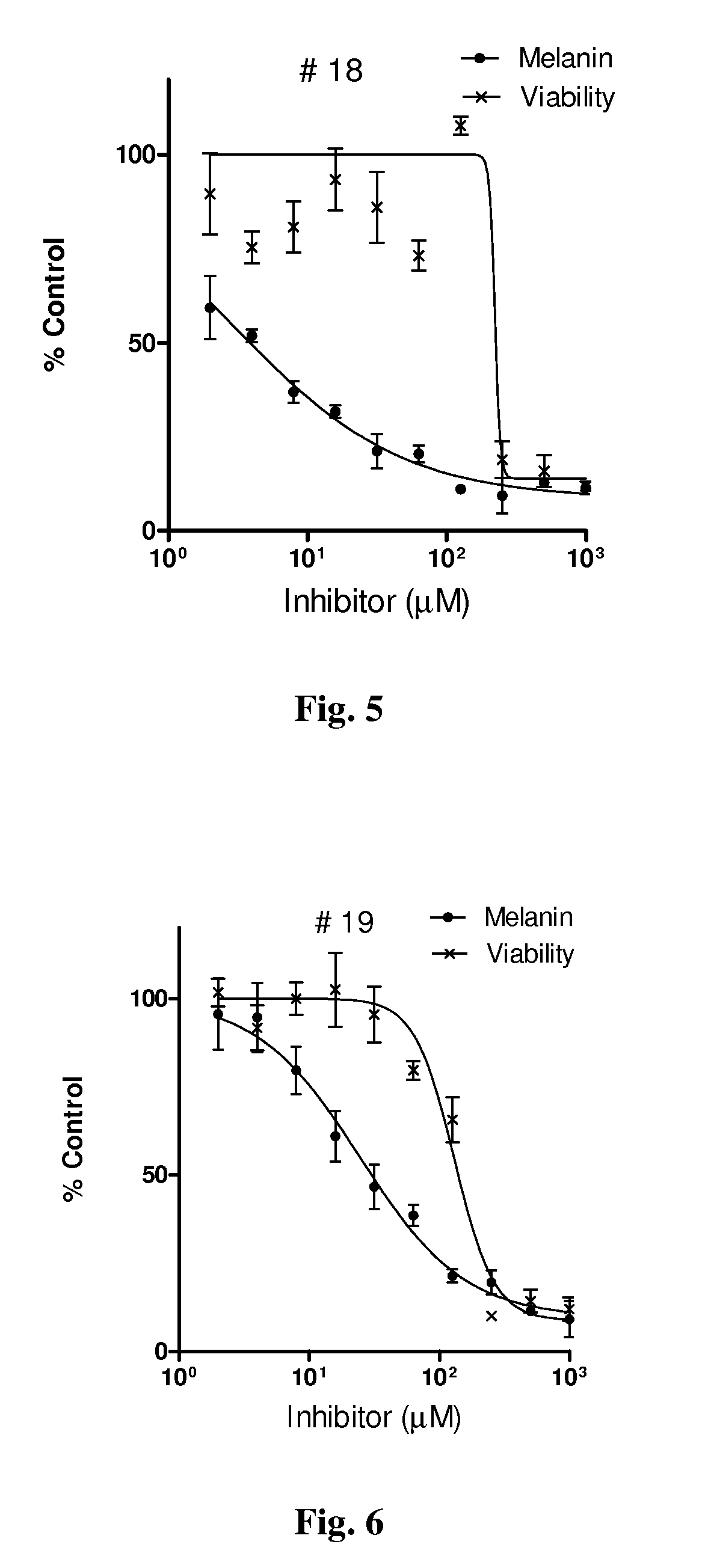Series of skin whitening (lightening) compounds
a tyrosinase inhibitor and tyrosinase inhibitor technology, applied in the field of new tyrosinase inhibitors, pharmaceuticals, dermatologic and cosmetic compositions, can solve the problems of few skin whitener properties, few purportedly active agents have been demonstrated clinically effective, etc., and achieve excellent inhibitory activity of tyrosinase, stable and easy to synthesize, and low cytotoxicity
- Summary
- Abstract
- Description
- Claims
- Application Information
AI Technical Summary
Benefits of technology
Problems solved by technology
Method used
Image
Examples
example 1
General and Specific Methods for the Synthesis of Compounds of Formula I
[0092]
[0093]Compounds of Formula I were prepared generally as set forth in Scheme 1, using a substituted bromobenzene as R for purposes of illustration. Briefly, the biphenyl compounds of Formula I were prepared by Kumada coupling reaction (Tamao, K.; Sumitani, K.; Kumada, M, Journal of the American Chemical Society. 1972, 94. 4374-4376) using Ni(dppp)Cl2 catalyst from the corresponding Grignard reagents with appropriate aryl bromide followed by reductive debenzylation reaction of benzyl group.
Representative Procedure for Scheme 1: Synthesis of 4′-Methoxybiphenyl-2,4-diol (1)
[0094]4-Bromoanisole (2.80 g, 15 mmol) was treated with magnesium turnings (480 mg, 20 mmol) and iodine (a pinch) in THF to make the corresponding Grignard reagent. The Grignard reagent was then added to a stirred solution of benzyl protected 4-bromoresorcinol (3.7 g, 10 mmol) and Ni(dppp)Cl2 (2.7 g, 5 mmol) in THF at 0° C. The reaction mixt...
example 2
General and Specific Methods for the Synthesis of Compounds of Formula II
[0100]
[0101]Compounds of Formula II were prepared as illustrated in Scheme 2. Briefly, with reference to Scheme 2, the diphenylmethane compounds illustrative of Formula II were prepared by Grignard addition reaction with an aldehyde (RCHO, wherein R=aromatic or heteroaromatic ring), followed by dehydroxylation of resulting benzylic hydroxyl group and debenzylation of benzyloxy protecting groups in situ.
Representative Procedure for Scheme 2: Synthesis of 4-(Furan-2-ylmethyl)benzene-1,3-diol (5)
[0102]Benzyl protected 4-bromoresorcinol (2.80 g, 15 mmol) was treated with magnesium turnings (480 mg, 20 mmol) and iodine (a pinch) in THF to provide the corresponding Grignard reagent, which was then added to a stirred solution of 2-furaldehyde (3.97 g, 10 mmol) in THF at 0° C. The reaction mixture was allowed to warm up to room temperature and stirred at room temperature for 3 h. The mixture was then quenched with amm...
example 3
General and Specific Methods for the Synthesis of Compounds of Formula III
[0112]
[0113]Compounds of Formula III were prepared as illustrated in Scheme 3, below. Briefly, with reference to Scheme 3, the 1,2-diphenylethene compounds of Formula III were prepared by Wittig reaction between the corresponding Wittig salt and aldehyde followed by hydrogenation with Pd on activated carbon and ammonium formate (AMF).
Representative Procedure for Scheme 3: 4-Phenethylbenzene-1,3-diol (12)
[0114]To a solution of the phosphonium salt of benzyl bromide (5.2 g, 12 mmol) in THF (25 mL), nBu-Li in hexane (6.9 mL, 11 mmol) was added at 0° C. The reaction mixture was allowed to stir at room temperature for 1 h, during which time the mixture developed a red color indicating the formation of ylide. A solution of 2,4-bis(benzoloxy)benzaldehyde (3.2 g, 10 mmol) in THF (10 mL) was added to the ylide solution at −80° C. and allowed to stir overnight without removing the low temperature bath. During that perio...
PUM
| Property | Measurement | Unit |
|---|---|---|
| Volume | aaaaa | aaaaa |
| Mass | aaaaa | aaaaa |
| Molar density | aaaaa | aaaaa |
Abstract
Description
Claims
Application Information
 Login to View More
Login to View More - R&D
- Intellectual Property
- Life Sciences
- Materials
- Tech Scout
- Unparalleled Data Quality
- Higher Quality Content
- 60% Fewer Hallucinations
Browse by: Latest US Patents, China's latest patents, Technical Efficacy Thesaurus, Application Domain, Technology Topic, Popular Technical Reports.
© 2025 PatSnap. All rights reserved.Legal|Privacy policy|Modern Slavery Act Transparency Statement|Sitemap|About US| Contact US: help@patsnap.com



